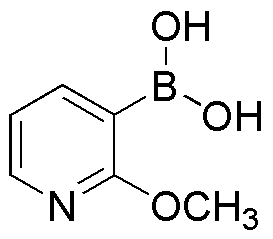2-Methoxypyridine-3-boronic acid is widely utilized in research focused on:
- Synthetic Chemistry: This compound serves as a versatile building block in the synthesis of various organic molecules, particularly in the development of pharmaceuticals and agrochemicals.
- Catalysis: It is employed as a ligand in palladium-catalyzed cross-coupling reactions, which are essential for forming carbon-carbon bonds in organic synthesis, enhancing reaction efficiency and selectivity.
- Bioconjugation: The boronic acid functional group allows for selective binding to diols, making it useful in bioconjugation techniques for drug delivery systems and targeted therapies.
- Material Science: It is used in the development of advanced materials, including sensors and polymers, due to its ability to form stable complexes with various substrates.
- Analytical Chemistry: This compound can be utilized in the development of analytical methods for detecting and quantifying certain biomolecules, providing a reliable tool for researchers in biochemistry.
General Information
Properties
Safety and Regulations
Applications
2-Methoxypyridine-3-boronic acid is widely utilized in research focused on:
- Synthetic Chemistry: This compound serves as a versatile building block in the synthesis of various organic molecules, particularly in the development of pharmaceuticals and agrochemicals.
- Catalysis: It is employed as a ligand in palladium-catalyzed cross-coupling reactions, which are essential for forming carbon-carbon bonds in organic synthesis, enhancing reaction efficiency and selectivity.
- Bioconjugation: The boronic acid functional group allows for selective binding to diols, making it useful in bioconjugation techniques for drug delivery systems and targeted therapies.
- Material Science: It is used in the development of advanced materials, including sensors and polymers, due to its ability to form stable complexes with various substrates.
- Analytical Chemistry: This compound can be utilized in the development of analytical methods for detecting and quantifying certain biomolecules, providing a reliable tool for researchers in biochemistry.
Documents
Safety Data Sheets (SDS)
The SDS provides comprehensive safety information on handling, storage, and disposal of the product.
Product Specification (PS)
The PS provides a comprehensive breakdown of the product’s properties, including chemical composition, physical state, purity, and storage requirements. It also details acceptable quality ranges and the product's intended applications.
Certificates of Analysis (COA)
Search for Certificates of Analysis (COA) by entering the products Lot Number. Lot and Batch Numbers can be found on a product’s label following the words ‘Lot’ or ‘Batch’.
Numéro de catalogue
Numéro de lot/série
Certificates Of Origin (COO)
This COO confirms the country where the product was manufactured, and also details the materials and components used in it and whether it is derived from natural, synthetic, or other specific sources. This certificate may be required for customs, trade, and regulatory compliance.
Numéro de catalogue
Numéro de lot/série
Safety Data Sheets (SDS)
The SDS provides comprehensive safety information on handling, storage, and disposal of the product.
DownloadProduct Specification (PS)
The PS provides a comprehensive breakdown of the product’s properties, including chemical composition, physical state, purity, and storage requirements. It also details acceptable quality ranges and the product's intended applications.
DownloadCertificates of Analysis (COA)
Search for Certificates of Analysis (COA) by entering the products Lot Number. Lot and Batch Numbers can be found on a product’s label following the words ‘Lot’ or ‘Batch’.
Numéro de catalogue
Numéro de lot/série
Certificates Of Origin (COO)
This COO confirms the country where the product was manufactured, and also details the materials and components used in it and whether it is derived from natural, synthetic, or other specific sources. This certificate may be required for customs, trade, and regulatory compliance.


